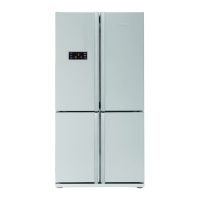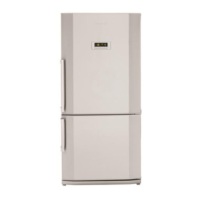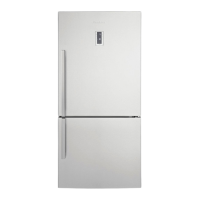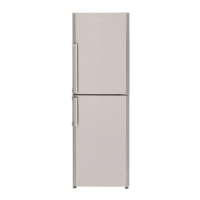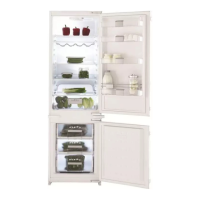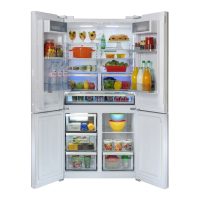Do you have a question about the Blomberg KSM 9660 XA+ and is the answer not in the manual?
Ensures safe operation of the refrigerating appliance with R600a refrigerant, emphasizing air circulation and avoiding mechanical aids.
Covers essential checks before connecting the appliance, including removing transit protectors and allowing oil to settle.
Provides guidance on safe disposal of old appliances and ensuring the appliance is used only for its intended purpose.
Advises against using the appliance in unheated rooms and stresses the importance of reading instructions for performance.
Details earthing requirements, R600a refrigerant safety, and warnings against improper electrical use or circuit damage.
Outlines proper transportation positioning, post-transport settling time, and protection against environmental influences.
Specifies optimal room temperature, placement away from heat sources, and required air circulation clearances.
Includes crucial notes on cleaning care, appliance stability, cable safety, and preventing children from tampering.
Provides guidance on storing fresh food, dairy products, cooked dishes, produce, and bottles in the refrigerator and freezer compartments.
Details recommended practices for storing raw meat, produce, beverages, and high-proof alcohol, including freezing advice.
Explains how to use the thermostat knob to set and adjust internal temperatures for optimal cooling.
Discusses achieving the desired temperature, normal temperature variations, monitoring, and the impact of frequent door openings.
Covers final checks before operation, normal operating sounds, cabinet characteristics, and initial temperature settings.
Provides guidance on storing frozen food and actions to take during a power failure to preserve food.
Offers instructions for optimal freezing of fresh food, including capacity limits and handling warm food inputs.
Details the simple process of making ice cubes using the provided ice tray.
Explains the automatic defrosting process for the fridge compartment and how to handle defrost water droplets.
Provides instructions for manually defrosting the freezer compartment, including food preparation and defrosting methods.
Step-by-step guide on how to safely replace the interior light bulb of the refrigerator/freezer.
Covers cleaning the interior, exterior, door seals, and defrost water container using recommended methods and materials.
Details polishing metal parts, cleaning the condenser, and preparing the appliance for long-term storage.
Guides the user through the process of repositioning the appliance doors for optimal functionality.
Offers practical advice on appliance placement, food transportation, and usage habits to minimize energy consumption.
Details best practices for storing various foods, including meat, poultry, vegetables, bread, and beverages.
Provides tips on freezing food in portions, wrapping, and thawing food in the refrigerator compartment.
Lists foods and items that should not be stored in the appliance, such as bananas, melons, and dangerous substances.
Advises against using sharp objects for ice removal, storing hot food, or leaving doors open excessively.
Explains normal operating noises from the compressor, refrigerant flow, and vibrations caused by the appliance.
Discusses how floor type, appliance leveling, and objects placed on the appliance can affect noise and vibration levels.
Provides initial checks for when the appliance does not operate, including plug, power supply, and circuit breaker status.
Advises contacting the dealer if the appliance remains non-operational after performing all checks.
Lists key technical specifications including brand, model, volumes, freezing capacity, energy class, power consumption, and noise level.
Ensures safe operation of the refrigerating appliance with R600a refrigerant, emphasizing air circulation and avoiding mechanical aids.
Covers essential checks before connecting the appliance, including removing transit protectors and allowing oil to settle.
Provides guidance on safe disposal of old appliances and ensuring the appliance is used only for its intended purpose.
Advises against using the appliance in unheated rooms and stresses the importance of reading instructions for performance.
Details earthing requirements, R600a refrigerant safety, and warnings against improper electrical use or circuit damage.
Outlines proper transportation positioning, post-transport settling time, and protection against environmental influences.
Specifies optimal room temperature, placement away from heat sources, and required air circulation clearances.
Includes crucial notes on cleaning care, appliance stability, cable safety, and preventing children from tampering.
Provides guidance on storing fresh food, dairy products, cooked dishes, produce, and bottles in the refrigerator and freezer compartments.
Details recommended practices for storing raw meat, produce, beverages, and high-proof alcohol, including freezing advice.
Explains how to use the thermostat knob to set and adjust internal temperatures for optimal cooling.
Discusses achieving the desired temperature, normal temperature variations, monitoring, and the impact of frequent door openings.
Covers final checks before operation, normal operating sounds, cabinet characteristics, and initial temperature settings.
Provides guidance on storing frozen food and actions to take during a power failure to preserve food.
Offers instructions for optimal freezing of fresh food, including capacity limits and handling warm food inputs.
Details the simple process of making ice cubes using the provided ice tray.
Explains the automatic defrosting process for the fridge compartment and how to handle defrost water droplets.
Provides instructions for manually defrosting the freezer compartment, including food preparation and defrosting methods.
Step-by-step guide on how to safely replace the interior light bulb of the refrigerator/freezer.
Covers cleaning the interior, exterior, door seals, and defrost water container using recommended methods and materials.
Details polishing metal parts, cleaning the condenser, and preparing the appliance for long-term storage.
Guides the user through the process of repositioning the appliance doors for optimal functionality.
Offers practical advice on appliance placement, food transportation, and usage habits to minimize energy consumption.
Details best practices for storing various foods, including meat, poultry, vegetables, bread, and beverages.
Provides tips on freezing food in portions, wrapping, and thawing food in the refrigerator compartment.
Lists foods and items that should not be stored in the appliance, such as bananas, melons, and dangerous substances.
Advises against using sharp objects for ice removal, storing hot food, or leaving doors open excessively.
Explains normal operating noises from the compressor, refrigerant flow, and vibrations caused by the appliance.
Discusses how floor type, appliance leveling, and objects placed on the appliance can affect noise and vibration levels.
Provides initial checks for when the appliance does not operate, including plug, power supply, and circuit breaker status.
Advises contacting the dealer if the appliance remains non-operational after performing all checks.
Lists key technical specifications including brand, model, volumes, freezing capacity, energy class, power consumption, and noise level.
| Appliance placement | Freestanding |
|---|---|
| Product colour | Stainless steel |
| Freezer net capacity | 122 liters |
| Energy Efficiency Class | A+ |
| Weight | 99 kg |
| Built-in display | Yes |
| Lamp type | LED |
| Number of shelves/baskets fridge | 4 |
| Number of vegetable drawers | 2 |
| Door balconies | 4 |
| Egg balcony | Yes |
| Bottle rack | Yes |
| Number of shelves/baskets freezer | 3 |
| Ice cube tray | Yes |
| Multi-Airflow system (fridge) | Yes |
| Fresh zone compartment | Yes |
| Annual energy consumption | 481 kWh |
| Width | 70 cm |
| Depth | 70.5 cm |
| Height | 192 cm |
| Number of Shelves | 4 |
| Number of Door Bins | 4 |
| Climate Class | SN-T |
| Fridge interior light | LED |


